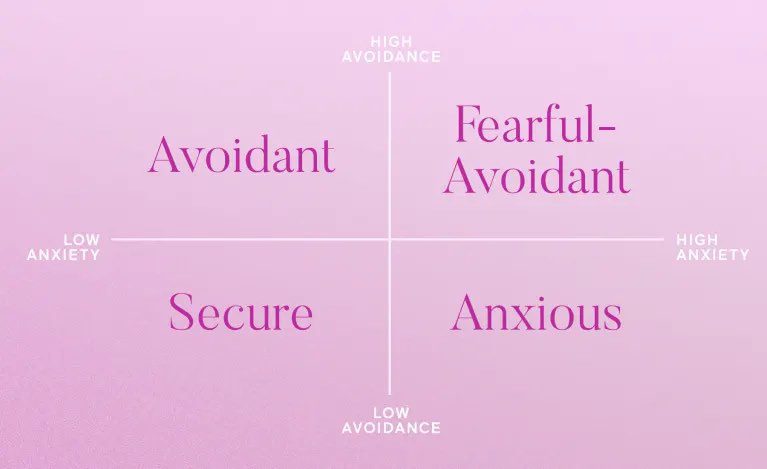
The 4 Attachment Styles
This site contains affiliate links to products. We may receive a commission for purchases made through these links.
What is Attachment Theory?
Attachment theory is a psychological, evolutionary and ethological theory concerning relationships between humans. The most important tenet is that young children need to develop a relationship with at least one primary caregiver for normal social and emotional development. – Wikipedia
Simply put, attachment theory focuses on the relationship you have with your parents and how this can affect your relationship with romantic partners.

1. Avoidant Attachment
Children with an avoidant attachment tend to avoid parents or caregivers, showing no preference between a caregiver and a complete stranger.
This attachment style might be a result of abusive or neglectful caregivers. Children who are punished for relying on a caregiver will learn to avoid seeking help in the future. This causes the person to become distant, cold and unable to express emotions in a relationship due to past childhood traumas.
The dismissive / avoidant type would often perceive themselves as ‘lone wolves’: strong, independent, and self-sufficient; not necessarily in terms of physical contact, but rather on an emotional level.
These people have high self-esteem and a positive view of themselves.
The dismissive / avoidant type tend to believe that they don’t have to be in a relationship to feel “complete”.
They do not want to depend on others, have others depend on them, or seek support and approval in social bonds.
Adults with this attachment style generally avoid emotional closeness. They also tend to hide or suppress their feelings when faced with a potentially emotion-dense situation.

2. Anxious(ambivalent) Attachment
These children become very distressed when a parent leaves. Ambivalent attachment style is considered uncommon, affecting an estimated 7% to 15% of U.S. children. As a result of poor parental availability, these children cannot depend on their primary caregiver to be there when they need them.
In a relationship, the person might become very clingy, insecure and unable to be alone in their own company. This can result in partners feeling overwhelmed by their neediness and unhealthy insecurities that stem from their childhood.
The thought of living without the partner (or being alone in general) causes high levels of anxiety. People with this type of attachment typically have a negative self-image, while having a positive view of others.
The anxious adult often seeks approval, support, and responsiveness from their partner.
People with this attachment style value their relationships highly, but are often anxious and worried that their loved one is not as invested in the relationship as they are.
A strong fear of abandonment is present, and safety is a priority. The attention, care, and responsiveness of the partner appears to be the ‘remedy’ for anxiety.
On the other hand, the absence of support and intimacy can lead the anxious / preoccupied type to become more clingy and demanding, preoccupied with the relationship, and desperate for love.

3. Fearful Avoidant (Disorganized)
These children display a confusing mix of behavior, seeming disoriented, dazed, or confused. They may avoid or resist the parent. Lack of a clear attachment pattern is likely linked to inconsistent caregiver behavior. In such cases, parents may serve as both a source of comfort and fear, leading to disorganized behavior.
In a relationship, the person is not able to express emotions at times or will become dismissive/avoidant of serious conversations relating to the status of their partnership.
The disorganized type tends to show unstable and ambiguous behaviors in their social bonds.
For adults with this style of attachment, the partner and the relationship themselves are often the source of both desire and fear.
Fearful-avoidant people do want intimacy and closeness, but at the same time, experience troubles trusting and depending on others.
They do not regulate their emotions well and avoid strong emotional attachment, due to their fear of getting hurt.
4. Secure Attachment

Children who can depend on their caregivers show distress when separated and joy when reunited. Although the child may be upset, they feel assured that the caregiver will return. When frightened, securely attached children are comfortable seeking reassurance from caregivers. This is the most common attachment style.
In a relationship, the person is able to express their emotions and give/receive love to their partner. This is the most common attachment style and healthiest of the 4 styles because it can lead to a healthy relationship. This does not mean that the relationship is perfect but it does mean that their is room to grow love and foster a healthy partnership.
Note that although a person can be a secure attachment style, it does not mean that this is permanent. Major traumas in life, like parents divorcing, death of a relative or coming in contact with an unhealthy/abusive partner can always alter this person’s attachment style over time.

What is your Attachment style?
After reading all of this, which attachment style do you think most personifies you with your partner?
Confused? Take the test instead and it will give you more information on how much of each style do you currently possess. We hope you enjoy this breakdown on this complicated theory and you are able to lead healthy and lasting relationships in your life.
Take a moment to watch the above video for some playful skits on these attachment styles and how they would look like in a relationship. Enjoy!
Final Thoughts
Whether you are secure or fearful avodiant attachment style, you can always change. But only if you want to. We encourage you to reflect on this theory and your childhood experiences.
Did anything in your youth make you fearful of love today? Has anything in your past made you avoidant from your partners?
All these questions should be asked and answered by yourself on your own time.
Share:

Victor Paredes
Victor Paredes is a contributor at FrankLegend.com and is based in Brooklyn. For inquiries reach out via email at victorhugoparedesx@gmail.com

Social Media
Most Popular



Amouranth and Frank Legend Collab

HOW AI AND CHATGPT WILL CHANGE THE STOCK MARKET
Subscribe To Our Weekly Newsletter
Categories
Discover the truth about height and dating and learn how to overcome height insecurity. Read on for the latest statistics on average height of men in the USA and tips for dating women. This light-hearted and humorous article will boost your confidence and help you stand tall!
What is attachment theory? What are the 4 attachment styles that can change your whole outlook on your relationships? Find out here.
Making a good first a impression is a very important skill you can learn to better raise your chances finding a job, friends or a date.
Being flirty and confident is a great way to attract a woman. Learn some tips on how to do this the right way. Read more here.
Marriage and Dating are very different things and today we will talk about the types of girls guys marry vs date.
Today we will talk about what to expect when it comes to dating a Latino. Learn how Latinos are in relationships today.
Men and women are not the same. There are double standards that men go through that women will never understand. Here are the 7 most infuriating double standards men deal with.
Find out if your relationship is one to last or is it destined to fail. Today we will talk about the 7 signs of an incompatible relationship.
Have a fun Halloween as we learn what are some of the best couple costumes that you and your significant other can do!









